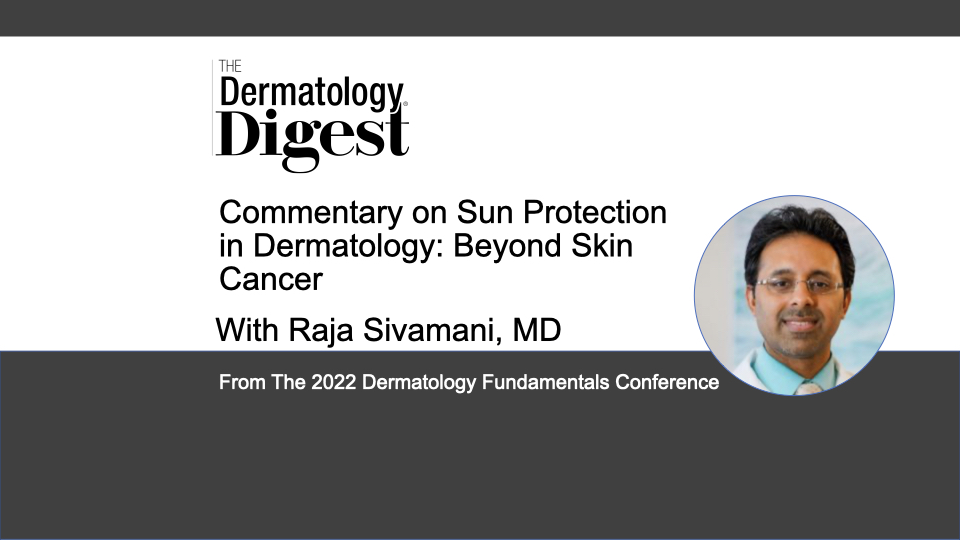Dr. Raja Sivamani discusses the need for a broader concept of sun protection as well as a more holistic approach to melasma.
Raja Sivamani, MD, is a board-certified dermatologist and ayurvedic practitioner, Pacific Skin Institute and Zen Dermatology, Sacramento, California.
“First of all, blue light may impact the skin and affect skin pigmentations. It is not adequately protected by sunscreens unless you are using a tinted zinc oxide-based sunscreen and other measures to try to protect against blue light exposure,” said Raja Sivamani, MD, who presented “Sun Protection in Dermatology: Beyond Skin Cancer” at the 2022 Dermatology Fundamentals Conference.
“The second thing… sunscreens aren’t the full approach to sun protection. They’re very, very, very important. They’re necessary, but it may not be sufficient to just use sunscreens because there are other sources of damage once the UV light gets past the sunscreen. You really have to think about an inside-out approach.”
Additional sun protection measures may include oral or topical antioxidants, oral anti-inflammatories, and topical iron oxides for blue light specifically, said Dr. Sivamani.
“[The presentation] was to really expand our knowledge base and the conversation around what it means to be sun protected.”
Sun Protection+
Among additional sun protective measures are vitamin E supplements, Polypodium leucotomos, and astaxanthin, said Dr. Sivamani. But these take more planning and commitment than simply applying a topical sunscreen.
“If someone wants to try to augment, say, vitamin E [with] a vitamin E supplement, they …have to do it for at least three weeks. You can’t just do it the day before you go out to the beach…. It has to be a little bit more of a lifestyle commitment.”
Polypodium leucotomos is an herb that’s fairly widely known and available, said Dr. Sivamani. Astaxanthin, a carotenoid, is less familiar.
“Astaxanthin is another one that you have to do at least 4 mg a day and it helps to augment your sun protection.”
According to Dr. Sivamani, the protective boost astaxanthin provides is deceptive. On its own it may offer a range of approximately SPF >1 to 3, but its use with sunscreens results in a multiplicative synergy.
“And so, if the sunscreen has an SPF of 10 [and] you add something else as SPF of 3, now you’re boosting the SPF by more than just the addition of the SPFs so that you get more than SPF of 13 because it’s in a series, one after the other.”
A Real-World Sunscreen Strategy
Most people don’t use the amount of sunscreen needed to adequately offer skin protection, said Dr. Sivamani.
“It’s easy for us to blame patients and say it’s their fault, but the truth is, even dermatologists that were asked to do this couldn’t apply sunscreens at 2 mg/cm2 on a single application. …so another little tidbit that we explored in the lectures was double application of your sunscreen.”
Adding that second layer will get you closer to the indicated amount, said Dr. Sivamani.
“And it doesn’t feel like you’re glopping it on all at one time. …people are very used to putting on one layer that’s thin, so if you do two thin layers back-to-back, it’s helpful.”
Applying sunscreen in layers may work similarly to layering foundation and sunscreen, he said.
“They’ve even done studies now showing that if you put on foundation before you put your sunscreen on, you boost the SPF, probably because your sunscreen doesn’t fall into all the little crevices in your skin and your foundation blocked all those crevices.”
Melasma
The formation of melanin is the pathophysiological factor of melasma that gets the most attention, said Dr. Sivamani, who also presented on pigmentary disorders. Treatment generally revolves around tyrosinase inhibitors like hydroquinone.
“But we’ve got to be more sophisticated than that. We’ve got other factors that are involved in melasma. Yes, you have melanin production, but you [also] have low-grade inflammation that needs to be addressed. You have melanin transfer from the melanocytes to the keratinocytes that can be addressed, for example, by soy [and] niacinamide.”
Addressing all these aspects is key to a holistic treatment approach, said Dr. Sivamani.
“When you start thinking in those terms, you start thinking about all the synergies that you can put together to really address melasma or just what we call dyspigmentation…. You’ve got to take more of a holistic approach.”
Low-grade steroids or other anti-inflammatories can be used to address inflammation, said Dr. Sivamani.
“[Skin cell] turn over—that’s where the retinoids come in.”
Dr. Sivamani and colleagues examined bakuchiol, a retinol alternative, to reduce the presence of pigment in a head-to-head study.1
“You’ve [also] got to have… visible light protection.”
Importantly, “holistic” is not a disregard for modern medicine, said Dr. Sivamani. It’s the opposite.
“When I say a holistic, I mean around the science and incorporating multiple perspectives that include conventional medicine. The science isn’t even being addressed holistically. So that’s what I want to try to expand in terms of both knowledge and therapies.”
Reference:
- Dhaliwal S, Rybak I, Ellis SR, Notay M, Trivedi M, Burney W, Vaughn AR, Nguyen M, Reiter P, Bosanac S, Yan H, Foolad N, Sivamani RK. Prospective, randomized, double-blind assessment of topical bakuchiol and retinol for facial photoageing. Br J Dermatol. 2019 Feb;180(2):289-296.
Disclosure:
Dr. Sivamani reports no relevant disclosures.

